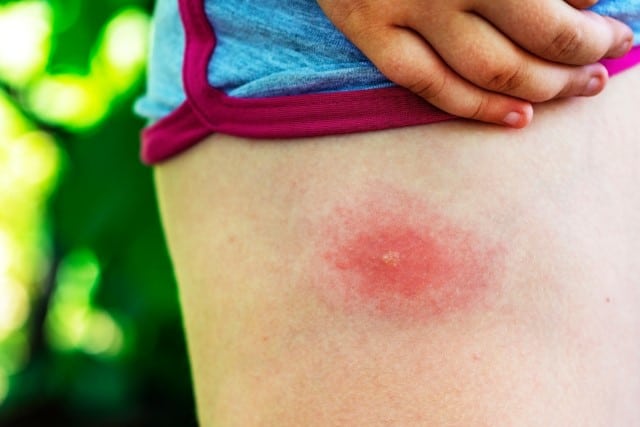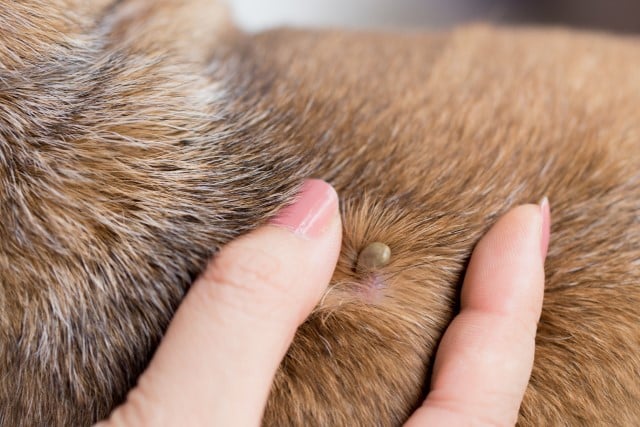Lyme disease is one of the most common diseases spread by ticks. Since ticks will feed on any warm- blooded animal and the deer tick is the most common Lyme Disease carrier, it’s natural to wonder: Do deer get Lyme Disease? And if so, can they transmit it to humans?
The good news is that these animals can’t pass Lyme Disease to humans. And it may surprise you to learn that all species of deer are immune to Lyme disease, so they will not exhibit any symptoms or pass the infection on to you. Deer also are not carriers of the disease, and they don’t spread it from tick to tick through their blood.
The only way humans can get Lyme disease is if they’re bitten by an infected tick.
The following article is a more detailed description of what Lyme disease is and how to identify and treat tick bites.
It also includes information on why, while deer themselves can’t get Lyme disease, they are still carriers of it, and their presence in the woods may contribute to the persistence of this illness.
What is Lyme Disease?
Lyme disease was first recognized by the United States in 1975, and it was first discovered in children living in Lyme, Connecticut.
The bacteria and main spreaders of the disease were not identified until 1982, and the spread of the disease has been increasing since then.

The east coast and the upper mid-west regions of the United States have the highest number of reported Lyme disease cases, most likely due to their climates.
The black-legged tick, formerly known as the deer tick, is the most common transmitter of Lyme disease.
However, when it was discovered that deer themselves are not Lyme disease carriers, the name was changed to avoid confusion.
The black-legged tick name came from the fact that this small tick has long black legs.
Lyme Disease Symptoms
Lyme disease has different symptoms depending on if an animal or a human is infected.
How Lyme Disease Presents in Animals
In animals (you primarily see it in house pets such as dogs), symptoms can take two to five months to appear after the animal is bit by an infected tick.

The most common symptoms of Lyme disease in animals are:
- Joint pain, especially in the knee and elbow joints, and
- Fever.
- In more severe cases, issues with the kidneys or heart can also be present.
The majority of the time and in most animals, Lyme disease will go away on its own.
Have you noticed any of these symptoms in your pet? If you do, you should bring them to a vet as soon as possible to make sure the symptoms don’t get any worse. If they do, it could lead to the death of the animal.
You should also take steps to prevent your animals from getting Lyme disease. Check them periodically for tick bites.
How Lyme Disease Presents in Humans
Humans can only get Lyme disease if an infected tick bites them and latches on for at least 24 hours. That is how long it takes to fully transmit the bacteria.
It will take one to two weeks for symptoms to show. Some Lyme disease symptoms that humans display include:
- Small red bump where the host was bitten
- Bulls-eye looking rash on or around original bite
- Fever
- Stiff neck
- Swollen lymph nodes
- Lethargy and fatigue
- Head and body aches
- Joint pain, usually in the knee
- Swollen joints
- In extreme cases, bacterial spread to the brain or heart
These symptoms do not all present at once, and the entire list of symptoms can take a few more weeks or even months to fully develop in a person with Lyme.
You should contact and visit your physician as soon as possible if you think that you’re infected, even if you don’t remember or didn’t see a tick embedded.
The best way to avoid getting infected is to avoid areas where ticks might be. A few places include:
- High brush areas
- Leaf litter
- Forested areas
If you do end up going into these areas, wear long sleeves, long pants, and close toed shoes to cover as much skin as possible.
Wearing light colors will also make it easier for you to find and brush away any ticks that might latch onto you.
Double check yourself for any ticks once you leave these areas, and make sure to wear gloves when removing the ticks and wash your hands afterwards.
It typically (though not always) takes ticks hours to bite deeply enough to transmit the disease, so prompt and regular tick checks are important.
How To Identify Tick Bites?
Identifying tick bites is the easiest and safest way to check if you might have Lyme disease. The sooner you catch the bite, the sooner you can get treatment and prevent the symptoms from getting worse.
The most obvious sign of a tick bite is actually witnessing a tick embedded into your skin.

However, ticks have to latch on for 24 hours straight in order to transmit the bacteria that causes Lyme disease to you.
Remove the tick with gloved hands and a pair of tweezers, and immediately wash your hands and the bitten skin afterwards.
You can also apply anti-itch cream and a disinfectant to help it heal faster and decrease the risk of infection.
Look for signs of tick bites on your body. They usually look like swollen red bumps with black specks in the middle, a bit like mosquito bites.

If you’ve contracted Lyme disease, you usually start to have symptoms within three days of a tick biting you. The bite also expands over the next 36 hours and develops the bullseye looking rash mentioned in the symptoms list.
Visit your physician as soon as possible or go to urgent care in order to receive immediate medical attention.
Checking Pets for Ticks and Tick Bites
The hair that covers a pet’s body makes it difficult to check most pets for tick bites.
You should be aware, as well, that they look a bit different on pets compared to humans.
Since the bites don’t cause a rash to spread on animals, it can be difficult to spot them. The easiest way to recognize a tick bite is to run your hands over your dog or cat, and catch the parasite in the act, and remove them immediately with tweezers.

You should also immediately bathe your pet in tick removing shampoo to get rid of any germs and wash away the remaining ticks.
When checking your pet for ticks, you will have to get as much fur out of the way as possible and look closely at your pet’s skin.
A tick bite on a pet or other animal looks somewhat similar to how it looks on a human. It’s generally a swollen red bump with a black dot in the center.
The main difference is that there likely won’t be a rash spreading across their skin.
If you’re unsure, or want advice, consult your veterinarian.
How Do Deer Spread Lyme Disease?
While deer themselves can’t contract Lyme disease, they do play a role in spreading it.
Ticks need to feed on blood before they lay eggs, and deer are the animal they most commonly feed on.

Humans come into contact with deer more often than other animals that ticks can feed on, such as birds and squirrels.
Deer are the most commonly hunted animal. And with urban sprawl, humans and deer find themselves sharing what was once the deer’s natural habitat.
However, hunting more deer won’t solve the increased spreading of Lyme disease.
If ticks can’t feed on deer, then they will find another host to feed on, and the cycle will continue.
Final Thoughts: Do Deer Get Lyme Disease?
As we’ve learned here, deer don’t get Lyme disease. However, they often serve as vital hosts in the life-cycle of ticks carrying Lyme disease.
If you spend a lot of time in nature hunting or even just exploring, you should take precautions against ticks. So when you venture into the habitat of deer (especially in regions known for a large tick population) you’ll encounter your share.
If you suspect you may have contracted Lyme Disease, you should contact your doctor for advice.


